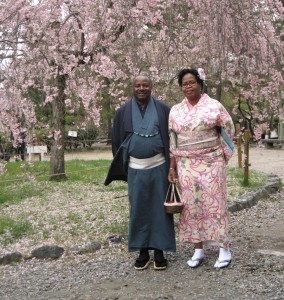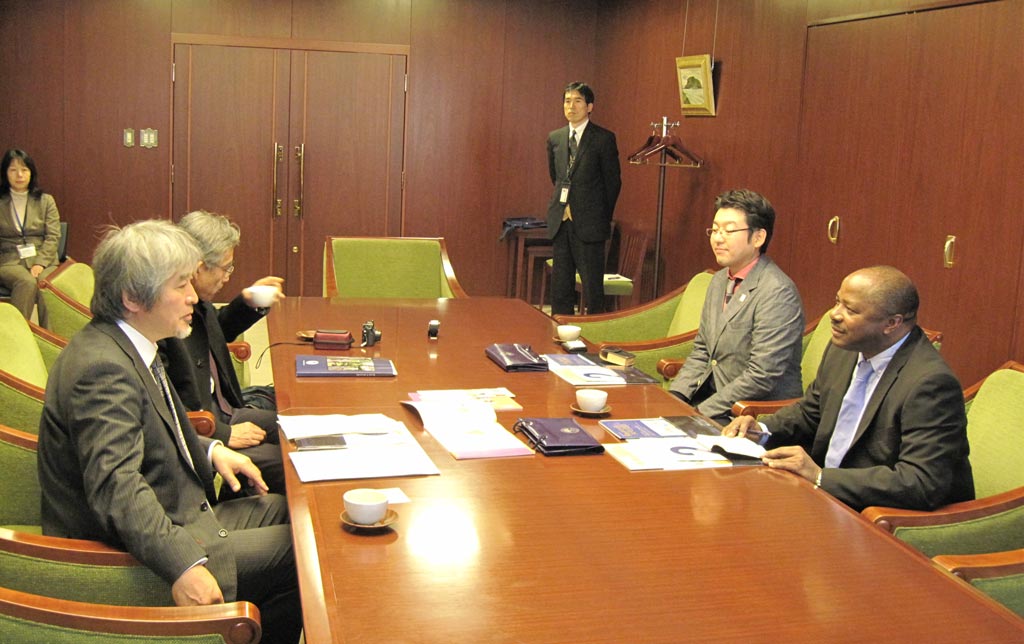Last week, Director General Nteranya Sanginga was in Japan to visit partner institutions and potential partners to explore new areas of collaboration. His week-long itinerary, 5-11 April, included visits to the Japan International Research Center for Agricultural Sciences (JIRCAS) and the National Institute of Agrobiological Sciences (NIAS) in Tsukuba; Kyoto University in Kyoto; Ministry of Agriculture, Forestry and Fisheries (MAFF), Ministry of Foreign Affairs (MoFA), Japan International Cooperation Agency (JICA), and Tokyo University of Agriculture (TUA) in Tokyo. On the final day he met with representatives of the private sector.
At JIRCAS, he was welcomed by the Management led by its President, Dr Masaru Iwanaga, former IITA Board member and Director General of CIMMYT. Dr Iwanaga had visited IITA last February. Sanginga made a presentation on “IITA: the leading research partner in Africa; Repositioning IITA for impact in Africa”. Sanginga and Iwanaga discussed further collaboration between JIRCAS and other universities and research centers in Japan.
At NIAS, Sanginga was welcomed by its President Dr H. Hirochika and visited the lab of the Anhydrobiosis Research Group working on the sleeping chironomid (Polypedilum vanderplanki) living in the semiarid regions of Africa.
At Kyoto University, which has a strong research ongoing in Kahuzi biega near Kalambo in DR Congo, a memorandum of understanding (MoU) was discussed. The university wants to establish a liaison office in Africa and this could possibly be hosted in one of IITA’s Hubs. With the new MoU, IITA would be able to work with 9 faculties, 19 graduate schools, and the 22,000 students of the university.
At TUA, the possibility was explored of working with IITA on other crops. TUA has seven IITA alumni among its professors and advanced research on yam is ongoing with IITA. It was agreed that new students would be posted to IITA this year.
The visits to the two universities not only enhanced collaboration but also provided an opportunity for Sanginga to introduce IITA to young students.
At MAFF and MoFA, the funding on cowpea and yam work was confirmed and the Tokyo International Conference on African Development (TICAD VI), a conference held every five years, was discussed. TICAD VI will be organized in 2016, possibly in Nairobi, and will concentrate on the agro-food system. TICAD aims to “promote high-level policy dialogue between African leaders and development partners.” IITA has been invited to organize a side event with JIRCAS.
This is the first time that IITA has engaged with JICA, one of the biggest dissemination agencies in Japan. The Director General will visit IITA this year, possibly around July. A new collaboration with JICA is expected to enable us to deliver our results to farmers more efficiently.
The last day of the visit was devoted to a meeting with the Japanese private sector: 42 participants and representatives from 22 companies joined the meeting. Officers from JIRCAS, NIAS, MAFF, MoFA, JICA, the Embassy of Nigeria in Japan, and the Embassy of Japan in Nigeria also attended the meeting. After this meeting, many Japanese companies will be expected to collaborate and to participate in IITA’s projects via the Business Incubation Platform (BIP) not only in Ibadan but in the hubs in Dar es Salaam, Nairobi, and Lusaka.
Sanginga expressed his appreciation for the support to IITA from Japan, not only in terms of funding, but also in the various kinds of collaboration, the exchange of ideas, and development of human capacities, including scientists and students.
The visit was organized by our Japanese scientists, Drs Sato Muranaka (JIRCAS), Haruki Ishikawa, and Kanako Suzuki.
At the end of the visit, Sanginga said, “I think that our travel was a great success and will enhance further collaboration and capacity building between IITA and Japan.”



No Comments